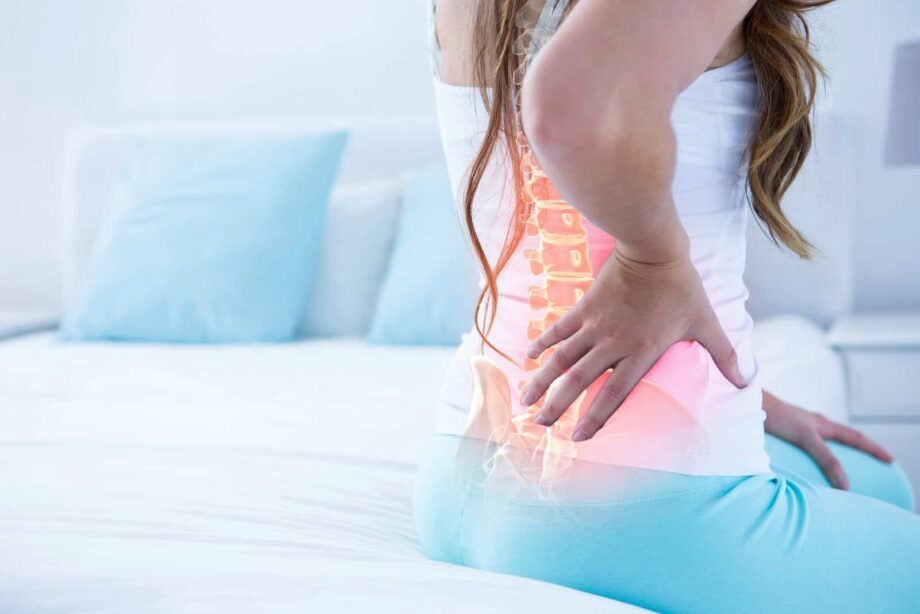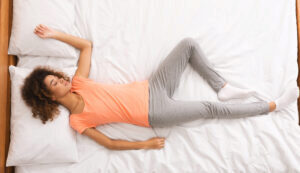Sleep and Back Pain
Disclosure: By clicking on the product links in this article, Mattress Nerd may receive a commission fee at no cost to you, the reader. Read full disclosure statement.
Mattress Nerd consulted Vivian Eisenstadt, MAPT, CPT, MASP, to ensure that this article met our editorial standards
The back is an amazing yet complicated structure. It’s made up of bones, joints, ligaments, and muscles that support our weight and protect our vital organs and nerve structures while also allowing for flexible movement. But when our back becomes injured, strained, or sprained, it can make standing up straight, lying down, or even sleeping seem impossible. Our guide provides strategies for addressing your pain so you don’t have to sacrifice your sleep.

Sleep Solutions for Back Pain
Is your back pain keeping you from drifting off when your head hits the pillow at night? If so, you are not alone. According to a study published in the European Spine Journal, there is a high prevalence of sleep disturbance in people who suffer from acute or chronic back pain. And, no surprise, the worse the intensity of the pain, the more likely sleep will be disturbed.
The good news is that your back pain doesn’t have to keep you up at night. There are strategies that may help you sleep better, including adjusting your sleep position, improving your sleep hygiene, and even better understanding the source of your pain.
Sleep Positions for Back Pain
When you have back pain, you may toss and turn to find a comfortable position. But be aware that sleeping in the wrong position can aggravate chronic or acute back pain, or create new pain. Here are some options for alleviating pain when you sleep:
Back sleepers
Sleeping on your back is the best position anatomically for most people — especially those who suffer from back pain. It evenly distributes body weight and puts less strain on the back. For best results, use a softer pillow with minimal loft to keep the spine aligned at the neck through the lower back. Putting a pillow under your legs beginning half way down the buttocks to the thighs can also reduce stress on your lower back.
While back sleeping is preferred for most people, it’s not recommended for anyone who snores or has obstructive sleep apnea unless the head is elevated either with a wedge pillow or an adjustable frame, according to the American Sleep Apnea Association. That’s because gravity encourages the soft tissues in the mouth to fall to the back of the throat, potentially blocking the airway.
Back sleeping is also not ideal for pregnant women in their second or third trimester, says the baby bump experts at What to Expect.
If you sleep on your back later in the pregnancy the weight of the fetus can press against your back, which can cause strain. It can also press on the vena cava, the main vein that carries blood back to the heart from your lower extremities. This can interfere with circulation and make you feel dizzy. For this stage, it is recommended to sleep on your side.
Side sleepers
Most people are more comfortable sleeping on their sides. This is generally considered a good position for back pain sufferers, but only if your mattress is soft and supportive enough. Side sleepers — especially those who suffer from or are prone to back pain — need a mattress that keeps their spine in alignment. Any strain on the spine while you sleep translates into backaches.
Side sleepers should also consider a pillow with enough loft to hold their heads so that their spine stays evenly aligned throughout the neck.
To keep your mid-spine from sinking, you can place a small rectangle or bolster couch pillow in the waist area below your ribcage to above your pelvis (when you put your hands on your hips you can feel the curve of the top of your pelvis so above there). This will maintain a neutral position side lying for your spine. For this position also put a regular pillow between your legs and slightly pulling your knees up toward your torso in a relaxed fetal position. You may also use a body pillow for extra comfort and support.
Stomach sleepers
Stomach sleeping is strongly discouraged by most medical professionals, including the American Chiropractic Association. That’s because doing so flattens the natural curve of the spine and strains the lower back. It also causes unnecessary pressure on your neck from twisting your head for prolonged periods with pressure on it.
If you must sleep on your belly, be sure you are using a soft pillow with very little loft so that your neck stays aligned with your backbone. Also try putting a thin pillow under your pelvis. This can help give your lower back more support so you wake with less pain.

More Strategies for Pain-Free Sleep
Now that we have covered some good sleeping positions to reduce and prevent further back pain, let’s review some other strategies for pain-free sleep.
#1 Look into your mattress
Sleep surface has a lot to do with the quality of sleep, especially when it comes to back pain sufferers. Older, sagging mattresses just don’t have the performance factors needed to support the lower back, relieve pressure points, and keep the spine aligned. Newer mattresses made with memory foam or latex, or a hybrid made with one of these foams with a core of innerspring, have been proven to help back pain sufferers sleep better.
According to a study published in the journal Applied Ergonomics, participants with back pain and stiffness experienced “progressive improvement in both back pain and stiffness while sleeping” after switching out their old mattress for a newer one. The new mattresses participants were provided with were layered with foam and latex and were of a medium-firmness.
#2 Pay attention to how you get in and out of bed
Back pain can make simple tasks like getting into and out of bed a challenge. There are techniques that limit movement and put minimal pressure on the back, which reduces back pain. One recommended by the Atlanta Back Clinic involves sitting on the edge of the bed and then leaning to the right or left side making sure to keep the spine aligned as you ease down to the mattress.
Bring your knees up to the mattress so that you are entirely on your side. Then, in one smooth movement, gently roll onto your back. Do the reverse to get out of bed. Because getting into and out of bed requires you to sit or lie on the edge of your mattress, you’ll want to be sure your bed has good edge support so it won’t sag too far when you sit on it.
#3 Prioritize your sleep hygiene
Sleep hygiene involves the habits that surround your bedtime. Adopting good sleep habits better ensures a good night’s sleep. Start by establishing a consistent sleep schedule in which you go to bed and wake up at roughly the same time every day, including weekends. Be sure you schedule at least 7-9 hours of sleep each night. Second, create a relaxing nighttime routine about 30 to 60 minutes before bedtime to help you release the day’s tension.
Take a warm bath, practice yoga or meditation, listen to gentle music or read a book. (But avoid electronic devices as they emit blue light which can stimulate the brain. Make sure that you don’t drink caffeinated drinks from mid-afternoon on. Drinking warm caffeine-free tea can help the body calm down before sleep. Finally, take measures to ensure your sleeping environment is cool, dark, and comfortable, and conducive to sleep.
Types of Back Pain
Most of us will experience back pain at least once in our lives. For some, the pain can be severe or persistent. Understanding the source of your pain is one of the first steps toward knowing how to treat it.
- Postural malalignment: With everyone working from home and on computers all day, our bones and muscles can get malaligned as the day goes on and we don’t switch positions. This can lead to muscle tightness, headaches, back pain upper to lower and muscle fatigue, tingling and numbness down the arms or legs.
- Muscle strains: Muscle strains occur when damage occurs to a muscle or its attaching tendons. This can happen when you are lifting something heavy or workout too hard. But it can also occur during regular activities if your muscles aren’t warmed up. Muscle strain can cause swelling, bruising, or redness as well as pain in the muscle even while at rest.
- Nerve pain: Nerve pain can be unpredictable. Most nerve-related back pain involves the sciatica nerve, the two largest nerves in the body that run from the lower back through the hips and buttocks and down each leg. When the sciatica nerve becomes irritated, inflamed, pinched, or compressed, the pain can be felt in the lower back and radiate down the leg to the calf or foot.
- Fractures and bone spurs: Bone pain is in a whole different league than muscle or nerve pain. It is usually caused by a fracture or bone spur. Fractures are literally broken or cracked bones that cause a deep ache. Bone spurs, on the other hand, are bony growths that occur on the edge of a bone, often along the spine. If bone spurs press on the nerves in the spine, it can cause weakness, numbness, or tingling in the arms or legs along with muscle spasms and cramps. The main cause of bone spurs is the joint damage associated with osteoarthritis.
When To See a Doctor
Sometimes back pain requires a visit to a medical professional to rule out more serious causes, such as fractures, tumors, or infections of the spine. Some warning signs to look out for include:
- Fever, which could signal infection.
- Trauma, such as a fall which could indicate a fracture.
- A current diagnosis of osteoporosis, which could mean a fracture has occurred.
- Numbness or tingling, which could indicate nerve irritation or damage.
- Loss of bowel or bladder function, which could be a rare but serious condition called cauda equina syndrome.
- History of cancer.
- Use of immunosuppressant therapy that could leave you prone to infections.
- Chronic use of steroids, which could also indicate a fracture.
- Prolonged use of IV drugs, because it can put you at risk for infection.
- Foot drop, or the need to lift your foot higher to prevent dragging toes along the ground, which may be a sign of a nerve, muscle or brain problem.
- Pain that occurs only at night while you’re trying to sleep.
- Unexplained weight loss, which may accompany infection or tumors.
- Pain that lasts six weeks or longer, as most causes of back pain go away within that time period.
- Advanced age, as being 70 years or older puts you at greater risk for infections, tumors, and abdominal issues.
Final Thoughts
If you are a sufferer of back pain, you are not alone. Up to 80% of the world’s population will experience a backache at some point in their lives, according to the American Chiropractic Association. When the bones, joints, ligaments and muscles in our backs become injured, strained or sprained, it can make even simple tasks — including sleep — feel monumental. But there are some strategies you can try to help reduce the pain you feel at night so you can sleep well and wake refreshed and ready to tackle the day ahead.
Meet Our Medical Reviewer
Vivian Eisenstadt, MAPT, CPT, MASP Vivian Eisenstadt is the founder of Vivie Therapy. Her private practice helps individuals with chronic and recent pain reclaim their lives quickly and thoroughly. Prior to founding her own practice, Vivian served as a Physical Therapist at Cedars-Sinai Medical Center. She specialized in treating spinal injuries, postural dysfunctions, sprains and strains, and general orthopedic injuries.



